This post shows you the 9 Easy and Healthy Postpartum Freezer Meal Ideas you can prepare before the baby comes!
As a mom-to-be, I did tons of research when it comes to the best postpartum meals and nutrients that you need for postpartum recovery.
My mom is also a doctor and a pediatrician, and she has her own workbooks that explain the best foods for breastfeeding and foods that generally help with postpartum recovery.
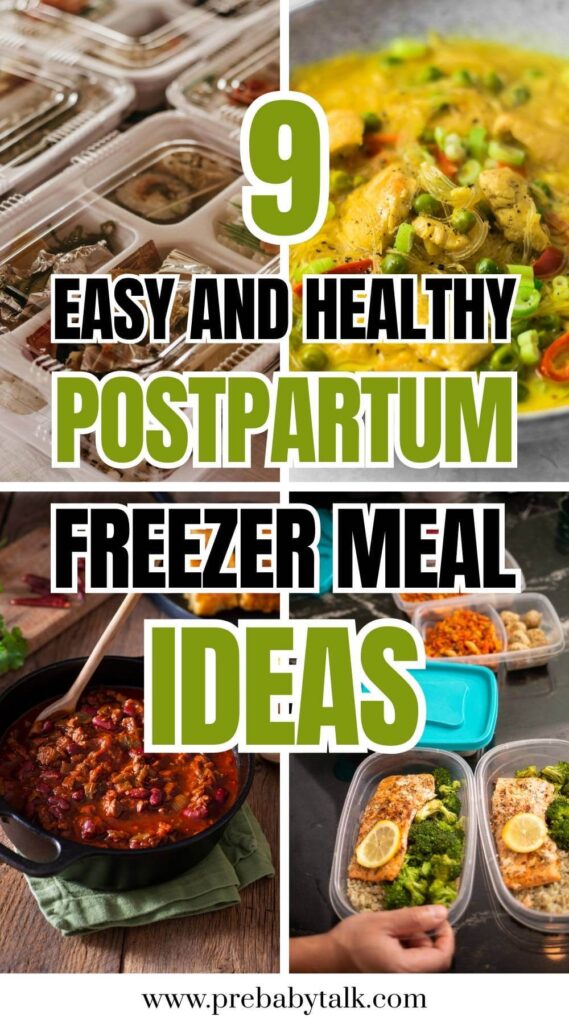
But, as someone who built this entire website just because I wanted to be prepared for everything before the baby comes, I spent months researching online studies about foods that support postpartum recovery, and that’s how I came up with this list.
In this post, I’ll show you some of the easiest and healthiest postpartum freezer meal ideas and tell you all about the food groups you need for fast recovery!
Healthy Postpartum Freezer Meal Ideas
All these postpartum freezer meal ideas focus on specific food groups that you’ll need for the best recovery (I talk about it at the end of this article!).
But, as someone who had to go through all of this and a full-time job, I can tell you that I chose them because they are easy to make!
1 Chili Con Carne

I made lots of chili by frying onions and garlic in olive oil, adding a bunch of red and yellow peppers, lean ground beef, and, once everything was almost done, adding tomato sauce and some tomato paste.
Once everything is almost cooked, I add Borlotti beans (they cause less gas!) and red kidney beans from a can, along with canned corn (natural, unsweetened).
When it comes to spices, I make the chili super mild. You never know if you’ll be able to handle hot and spicy. The good thing about chili is that you can always add some chili powder, cumin, and chili flakes once you have heated it up.
What makes chili con carne an amazing postpartum freezer meal?
- it has protein from both animal (beef) and plant sources (beans)
- it has veggies (peppers are a great source of vitamin C)
- it’s easy to make!
The chili will be fine in your freezer for the next 4–6 months.
How to eat it for the easiest experience?
- Eat it with some cooked rice, cooked potatoes, cooked bulgur, or cooked quinoa. It’s best that you don’t cook the grains and freeze them but cook them when you want to defrost and heat the chili.
- You can freeze cooked rice and cooked quinoa. They freeze well. That’s how you’ll have a complete meal frozen and ready to reheat.
- Get some whole-grain tortillas and fill them with chili and some shredded lettuce. Make a wholesome burrito!
2 Bolognese Sauce
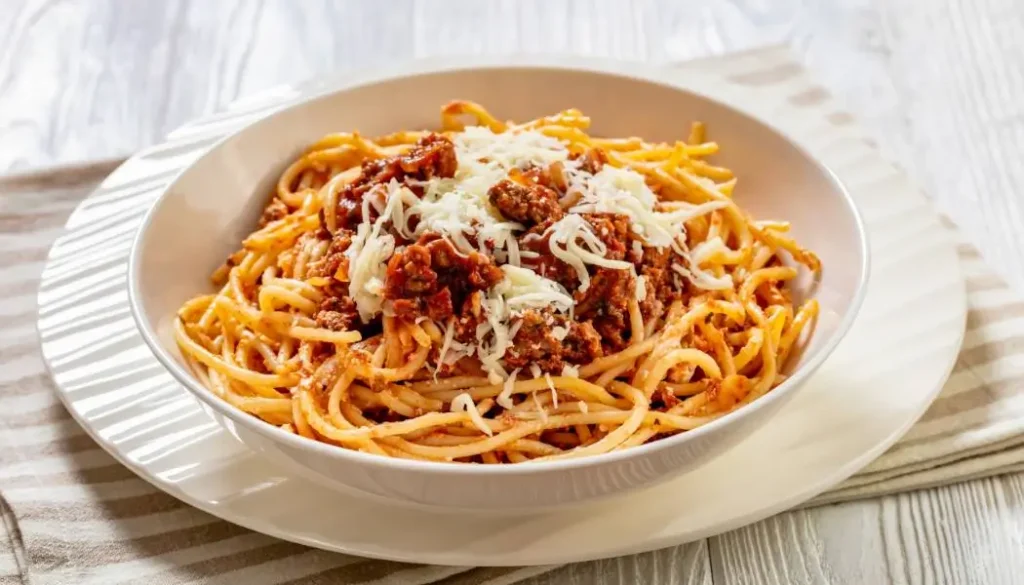
If you’re gonna be making Chili Con Carne, you can buy more ground beef and make a bolognese sauce at the same time!
I make mine by frying finely chopped onions and minced garlic in olive oil, and I add ground beef. Once the beef is almost ready, I add a can of chopped tomatoes and a whole jar of pasta sauce. I cook until done and then add oregano.
What makes bolognese sauce an amazing postpartum freezer food?
- it’s low in calories, and it freezes really well
- it’s a great source of protein
The bolognese sauce will be fine in your freezer for the next 3 months.
How to eat it for the easiest experience?
- Just cook some whole-grain pasta and enjoy! I like to eat mine with spaghetti, but I also eat it with penne rigate and fusilli! It’s a bit controversial, but I like to add some crumbled feta cheese for extra protein and calcium (if you’re Italian, please don’t come after me!)
3 Chicken Curry with Lots of Veggies
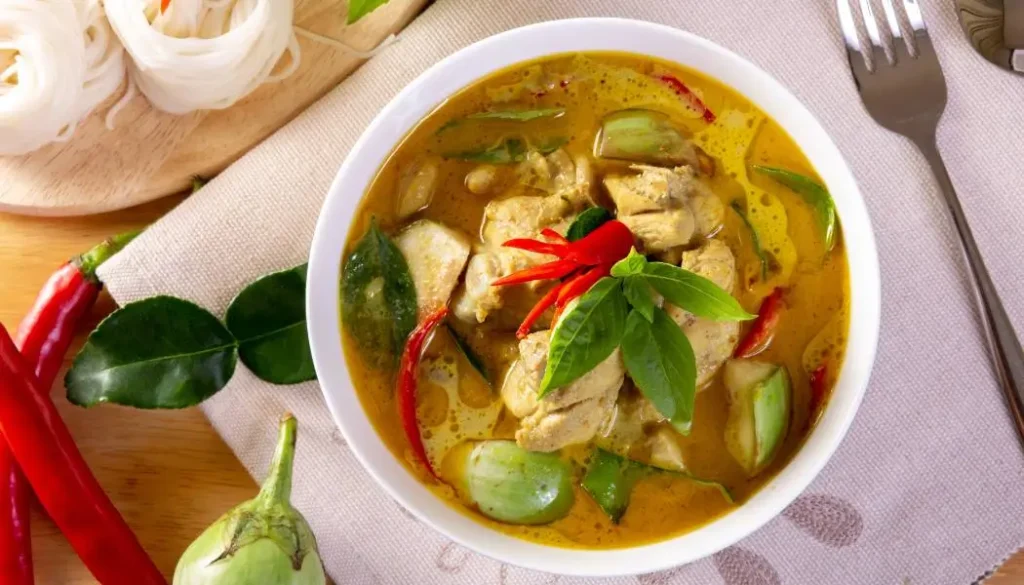
Another meal where you’re gonna get protein and fiber, lots of nutrients, and everything will be low in calories!
I make chicken curry by frying chicken with some onions in olive oil. Once the chicken is done, I remove it from the pan and, in the same pan, add a whole bag (or two) of frozen Asian mixed veggies. That’s my perfect mix for a curry!
My favorite mix has carrots, leeks, green beans, peas, cabbage, cauliflower, bamboo, red pepper, and mushrooms.
But any Asian-style or curry veggie mix will work.
You can use fresh veggies, too. Just don’t use zucchini or eggplant, as they turn horrible and mushy once frozen and reheated.
I use pre-made curry sauce (korma curry is my favorite), and I use both milk cream and coconut milk. I add the sauce and milk cream once the veggies are done.
Coconut milk freezes better, but for me, milk cream works just fine. The only difference is that you have to stir it several times as it defrosts and heats up in the microwave, but it’s not a big deal to me.
What makes chicken curry an amazing postpartum meal?
- lots of protein and veggies
- lots of spices that have anti-inflammatory properties
- Super easy to make
The chicken curry will be fine in your freezer for the next 3 months.
How to eat it for the easiest experience?
- you can cook rice or quinoa and make curry bowls and freeze them like that
- eat it with a cooked potato or cooked pumpkin
- eat it with rice noodles
- fill in a tortilla with chicken curry and add shredded cabbage or shredded iceberg salad with shredded carrots
Some foods don’t freeze really well
Just a side note – I usually don’t freeze cooked rice, quinoa, pasta, and potatoes, as it takes only 15 minutes to make them, and I prefer the taste when they are fresh. This is something you can make while carrying the baby, so no need to make it in advance!
4 Stir-Fried Chinese Chicken (Kung Pao or Seven Spices)

I’m listing Kung Pao and Seven Spices as my favorites! But any Chinese stir-fry chicken will be an amazing postpartum freezer meal!
And I’ll tell you why! You will crave something healthy and hearty. It’s super boring and dull to eat sandwiches or McDonald’s takeaway, but eating foods like stir-fries and curries with tons of veggies gives you more energy!
You will get enough protein, solve any issues with constipation, and travel in taste during those sensitive moments when life can feel a bit bland (I don’t really want to say boring).
I make my stir-fries by frying chicken in olive oil. Once it’s half done, I add the sauce.
My Chinese homemade sauce:
- I make my sauce by heating up some honey in the microwave (so I can mix it well; 10 seconds on medium is enough).
- Then I add minced garlic and seven Chinese spices (star anise, cinnamon, fennel, Szechuan peppers, cloves, white pepper, and black pepper).
- Next, I add white rice vinegar.
- And soy sauce.
This is something like sweet and sour chicken mixed with seven spices, cooked Kung Pao style. It’s my personal favorite mix, but you can tweak this recipe idea to your liking!
When it comes to veggies, I use bell peppers, carrots, and cabbage. I only cook them for a minute or two. It’s better if you undercook them slightly and then freeze them!
What makes a Chinese stir-fry an amazing postpartum meal?
- good source of protein and fiber
- low in calories
- rich in taste, spices are anti-inflammatory, and spices can boost your mood
The Chinese stir-fry will be fine in your freezer for the next 3 months.
How to eat it for the easiest experience?
- with some glass noodles or any kind of rice noodles! They are done in 5 minutes and very easy to digest.
- with cooked rice or quinoa
5 Lasagna
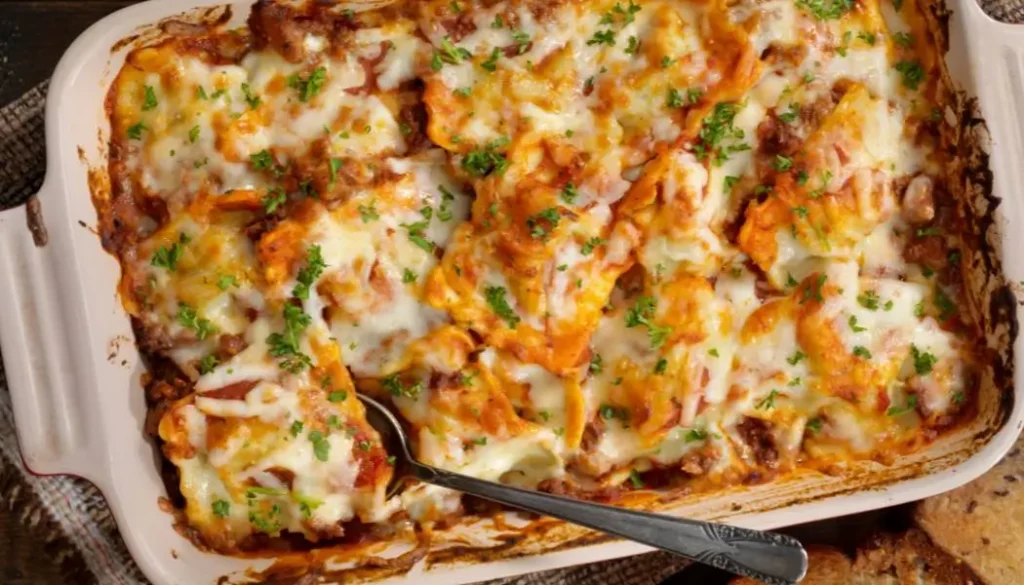
Now, lasagna is really a staple freezer meal that you can bake before the baby comes! You can make a huge batch and freeze it in portions that fit your nutritional and calorie needs.
I make classic lasagna, with the exception that I always use nutmeg to make the bechamel sauce, even though many recipes don’t include nutmeg.
To me, it’s the best and dreamiest flavor.
What makes lasagna an amazing postpartum meal?
- easy to make in a huge batch
- easy to freeze and tastes amazing once reheated
- high in calories and a complete meal
- has protein, dairy, and carbs
Lasagna will be fine in your freezer for the next 3 months.
If you have a huge freezer, you can also freeze one whole lasagna unbaked!
What is the best way to eat lasagna?
- I always combine pasta dishes and lasagna with a big bowl of salad. Since lasagna lacks fiber, it’s a good idea to eat a bowl of salad with it for lunch or dinner.
- Some of the best salad mixes include lettuce, watercress, arugula, spinach, red cabbage, and cherry tomatoes with olive oil and balsamic vinegar.
6 Greek-Style Gyros Chicken
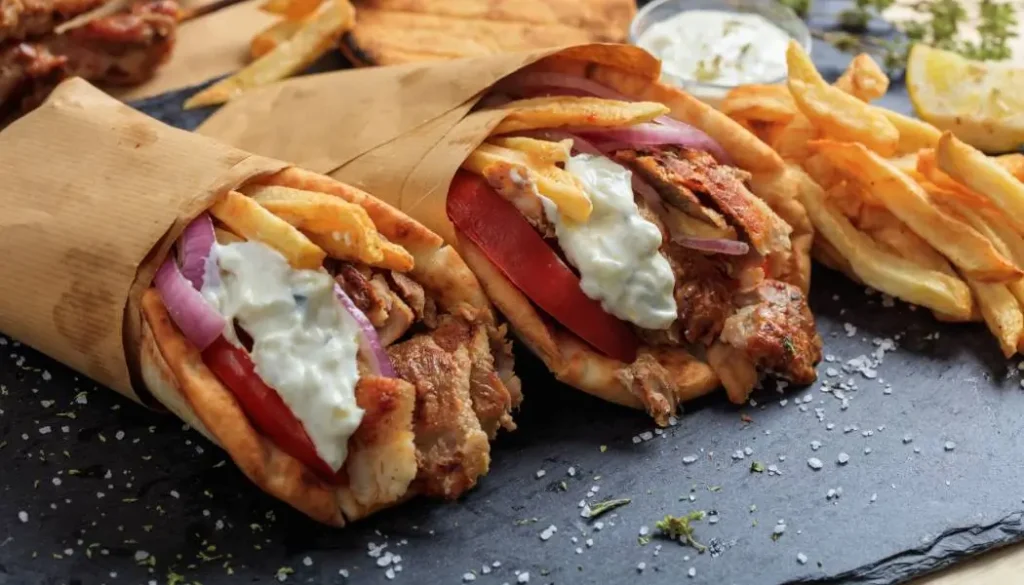
I love making Greek food at home, and gyros chicken is one of the easiest things to make!
All it takes is to buy some Gyros seasoning mix and use it to season the chicken. Watch out for the salt, as most seasoning mixes contain salt.
It’s also a good idea to marinate the chicken in some olive oil, add the Gyros spices, and leave it for about 30 minutes in the fridge.
Then, heat up the pan and fry it on high heat. After a couple of minutes, decrease the heat. Once the meat is ready, add a spoonful of Greek yogurt and a teaspoon of mustard. Stir well, and enjoy!
What makes Greek-style Gyros Chicken an amazing postpartum meal?
- great source of protein
- super versatile and goes well with both salads and wraps
Greek-style Gyros Chicken will be fine in your freezer for the next 2–3 months.
How to eat Greek-style Gyros Chicken?
- in pita bread with tzatziki and tomatoes
- in a wrap as a burrito, where you can add iceberg lettuce for more fiber
- in a salad bowl with leafy greens, lettuce, tomatoes, and arugula
When I was looking for postpartum freezer meal ideas, I really wanted to focus on the nutrients, but at the same time, I wanted to make sure that my meals were low to moderate in calories, as I wanted to nourish my body but give it a chance to burn the extra fat.
Choose meals that go really well with salads
You’ll notice that I often add a bowl of salad as a side dish and that I suggest adding lettuce to burritos and wraps. That’s because I want to feel full (kinda like the volume eating philosophy) and, at the same time, keep my meals lower in calories. And extra fiber is essential for good gut health, where more than 80% of your immune system comes from!
There’s nothing wrong or bad with gaining weight in pregnancy, and to me, that was kind of an amazing experience, as I knew my growing body was giving my baby food and shelter.
But I really wanted to feel like my usual self, so these meals that I could eat with veggies and salads were a lifesaver for me.
7 Beef and Veggie Stew

A classic beef and veggie stew is perfect for meal prep! Once reheated, you can eat it with some whole wheat bread (or sourdough) or cooked potatoes (to keep it low in calories).
I make mine in a crockpot as it’s super easy, and I make my stew with lots of onion, carrots, and mushrooms. Once everything is ready, I like to split the portions into freezer bags and make sure I have plenty!
Let me tell you what makes Beef and Veggie Stew an amazing postpartum meal:
- it’s nourishing and healthy and can be a great option when you need extra calories or something low in calories!
- high-calorie option: eat it with cooked rice or bread
- low-calorie option: eat it with cooked cauliflower or broccoli
Beef and veggie stew will be fine in your freezer for the next 2–3 months.
8 Lentil Curry (Dal)
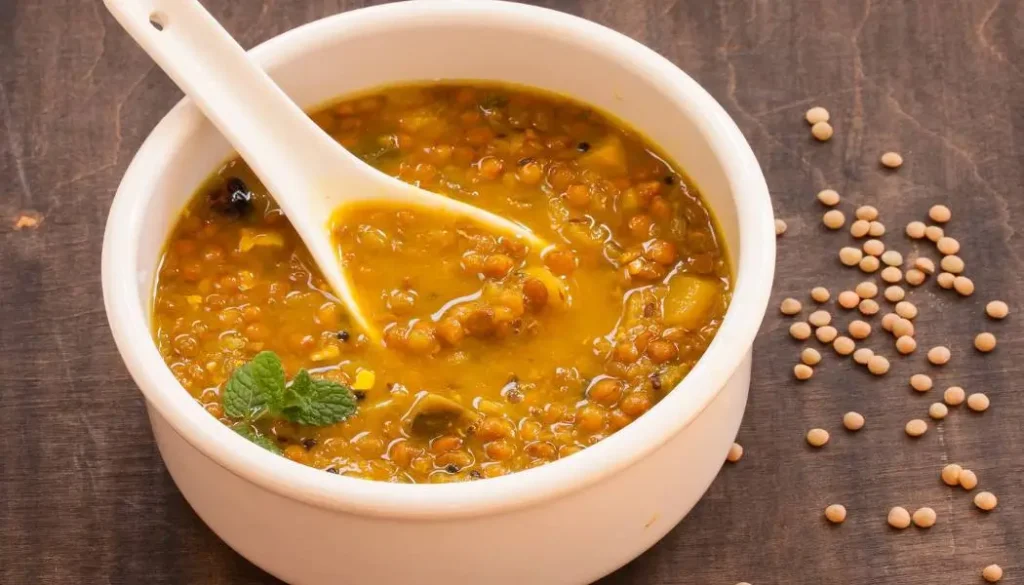
For everyone who’s looking for a vegetarian but protein-rich meal, there’s nothing better than lentil curry (dal). It’s a nourishing, wholesome postpartum freezer meal.
I make mine with red lentils, as they’re easier for me to digest (less gassy!), but you can also use green lentils if that works better for you.
I start by sautéing garlic in olive oil. Then, I add a jar of tomato sauce, the lentils, and a mix of chopped veggies. I usually go with carrots, bell peppers, and finely chopped zucchini.
I make sure to add zucchini at the end, so it’s slightly undercooked. It’s okay to let zucchini get mushy when reheated, as lentil curry is pretty dense, and you’ll want it a bit mushy!
I also add a bunch of kale — it’s such a great source of iron and calcium. If you don’t like kale you can add spinach!
My go-to spices for lentil curry include:
- cumin, turmeric, ground coriander, paprika, ginger, cinnamon, curry powder, and a pinch of chili flakes (optional if you want it mild)
What makes Lentil Curry (Dal) a nourishing postpartum meal?
- high in fiber and plant protein
- low in calories and great for volume eating
- it has lots of nourishing spices with anti-inflammatory properties
- it will keep you full for a really long time, so it’s good for postpartum weight loss
Lentil curry will be fine in your freezer for the next 3 months.
What is the best way to eat lentil curry?
- I eat mine straight from a big bowl, topped with a spoonful of plain yogurt. It’s so comforting and filling!
- You can also eat it with cooked rice or quinoa or scoop it up with whole-grain naan or flatbread.
9 Stuffed Bell Peppers
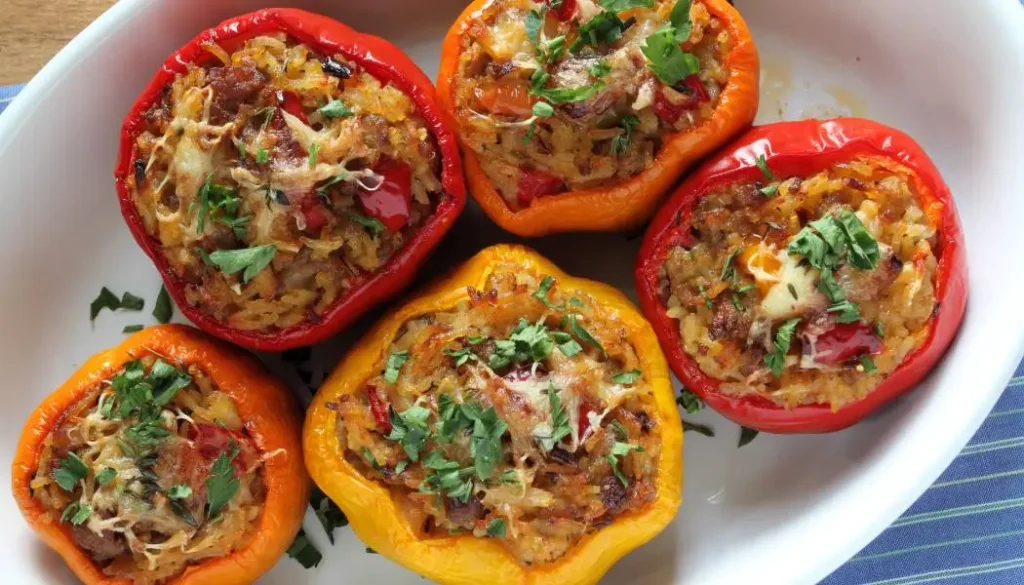
Stuffed bell peppers are one of my go-to postpartum freezer meals.
It takes a while to make them, so I guarantee you won’t have time to make them with a baby.
They are really good frozen and reheated.
I use ground beef to make the filling, and I mix it with rice, finely chopped onions, and carrots.
I make sure not to overcook the rice for the stuffing. It will cook in the pepper with all the juices!
Once I stuff the peppers, I cook them in tomato sauce that I dilute with water so the peppers stay intact but are juicy and tender.
Once the peppers are stuffed, I cook them in a tomato sauce that I dilute with water so the peppers stay juicy and tender.
Use the recipe you like the best! Don’t have to listen to me!
What makes Stuffed Bell Peppers an amazing postpartum meal?
- a complete meal with protein, veggies, and carbs
- easy to portion and freeze
- cooked in tomato sauce, which is rich in vitamin C and flavor
Stuffed bell peppers will be fine in your freezer for the next 3 months.
What is the best way to eat stuffed bell peppers?
- Reheat them in the microwave or oven and eat them as they are — they’re already a complete meal!
- If you want to add some fiber, you can serve them with a side of shredded cabbage salad or a simple green salad with olive oil and lemon.
Realistic Side Notes From Someone Who Made All of These Postpartum Freezer Meals
- I don’t freeze cooked pasta or potatoes. It takes literally minutes to make them, and it’s a good idea to do something manually with your hands other than taking care of the baby.
- I don’t freeze bread or pastry.
- I don’t freeze simple things like the veggie base for Shakshuka, as it takes a couple of minutes to prepare.
- I rarely have frozen breakfast options, as I eat oatmeal with fruit, eggs, omelets, or sandwiches with whole wheat bread.
- I rarely and almost never freeze baked goods. It simply doesn’t work for me.
- I don’t freeze cooked salmon or any type of fish. It’s best to buy it fresh, and this is something my husband gets every week. We make it in the oven in just 20 minutes.
- No matter what people on the internet say, it’s not a good idea to freeze cooked burgers. It’s better to form the burger patties, separate them with parchment paper, and then take them out in the morning to thaw and cook them for lunch!
How to Actually Prepare All of These Postpartum Meals?
Here’s how I did it.
I made everything over the course of 3 weeks. I would buy double the ingredients and cook only one dish per day.
We would eat whatever we prepared for lunch or dinner, and then freeze the rest (once it had cooled down).
We used freezer bags and wrote the date when we made it.
I used a scale to make sure that we split everything into good portions. Sometimes my husband would take two, but we stick to normal-sized portions.
Don’t try to cook everything in one week. You’ll get so tired. It’s better to spread the entire cooking process over several weeks.
Postpartum Freezer Meals Shopping List
If you want to follow this “meal plan”, you’ll need:
Proteins
- lean minced beef
- ground beef (for stuffed peppers)
- chicken breasts or thighs
- red lentils (or green lentils as an alternative)
- Greek yogurt
Grains & Carbs
- white or brown rice
- quinoa
- bulgur
- whole grain pasta (spaghetti, penne rigate, fusilli)
- rice noodles or glass noodles
- cooked rice (if freezing it with meals)
- cooked quinoa (if freezing it with meals)
Canned & Jarred Items
- chopped tomatoes (cans)
- tomato sauce
- tomato paste
- canned corn (unsweetened)
- canned red kidney beans
- canned Borlotti beans
- curry sauce (korma or your favorite)
- coconut milk
- milk cream
- soy sauce
- white rice vinegar
- honey
Vegetables (fresh or frozen)
- frozen Asian-style veggie mix (with carrots, leeks, green beans, peas, cabbage, cauliflower, bamboo, red pepper, mushrooms)
- kale
- bell peppers (red, yellow, green)
- onions
- garlic
- carrots
- peas
- cabbage
- zucchini (used in dal, not stuffed peppers)
- mushrooms
Spices & Seasonings
- salt
- black pepper
- white pepper
- chili powder or chili flakes (optional)
- ground cumin
- turmeric
- curry powder
- ground coriander
- ginger
- cinnamon
- paprika
- oregano
- nutmeg (for lasagna bechamel)
- thyme
- seven Chinese spices
Other Condiments & Cooking Essentials
- mustard
- olive oil
Postpartum Nutrition and Food Groups to Focus On

The best possible diet and nutrition plan you can follow during your postpartum recovery—but also during pregnancy, the lactation period, and life in general—is the Mediterranean diet. It’s an anti-inflammatory diet/lifestyle plan that focuses on healthy fats, proteins, fruits and veggies, and whole-grain carbs. Let’s break it down.
Protein
Everyone is raving about protein intake, but during your postpartum recovery, you have to make sure that you’re eating enough protein and getting enough iron. It’s essential!
You’ll need to eat:
- red meat (beef, lamb, pork)
- poultry (chicken and turkey)
- fish and seafood (fish, crab, squid)
- eggs
- dairy (hard cheese, feta, Greek yogurt)
Plant-Based Sources of Iron
Along with getting your iron from animal sources, you need to focus on healthy plant-based sources of iron during your postpartum recovery.
You’ll need to eat:
- legumes and beans (chickpeas, black and red beans, lentils)
- dark leafy greens (spinach, kale, broccoli)
- whole oats, quinoa, grains
- tofu and soya
Please remember that your body can’t absorb iron from plant-based sources as well as it can from animal sources, so if you’re a vegetarian, you’ll need to include a lot of iron-rich foods and supplements.
Healthy Fats
You need healthy fats for energy! The best fat sources are the ones that combine fat and protein, like oily fish!
Your best options here are salmon, sardines, and mackerel! They have EPA and DHA that help with the baby’s development (if you’re breastfeeding) and postpartum depression.
Then you’ll need to eat:
- extra virgin cold-pressed olive oil
- avocado
- butter
- nuts (almonds, hazelnuts, walnuts, cashews)
Whole Grains and Healthy Carbohydrates
You need to pick whole grains, as they are not only healthy carbs but also a great source of iron and minerals like zinc and magnesium. You’ll also find your natural source of fiber here!
Eat the following:
- oats
- brown rice
- quinoa
- chia, flaxseed, and sesame seeds
- whole grain pasta
- sourdough bread and whole-grain bread
- Whole-grain tortillas
Fruits and Vegetables
When it comes to fruits and vegetables, there’s only one rule, and it’s pretty simple—eat all of them and don’t worry about the portion size! Honestly, the number of people who focus on calories from fruit is insane when we should be focusing on reminding ourselves to eat fruit every day!
Don’t be the type of person who will eat a protein bar (ultra-processed, by the way) and count the calories in a banana.
My advice is to eat what is in season and to buy and cook with frozen veggies and fruits!
Thinking and planning things in advance to prepare for a baby are all part of the Pre-Baby Talk. That’s why, when the baby comes, you’ll be ready and prepared for…
…all the love in the world.
Which of these postpartum freezer meal ideas did you like the most? Let me know in the comments!
Don’t forget to pin this post so you’ll always have these ideas handy!
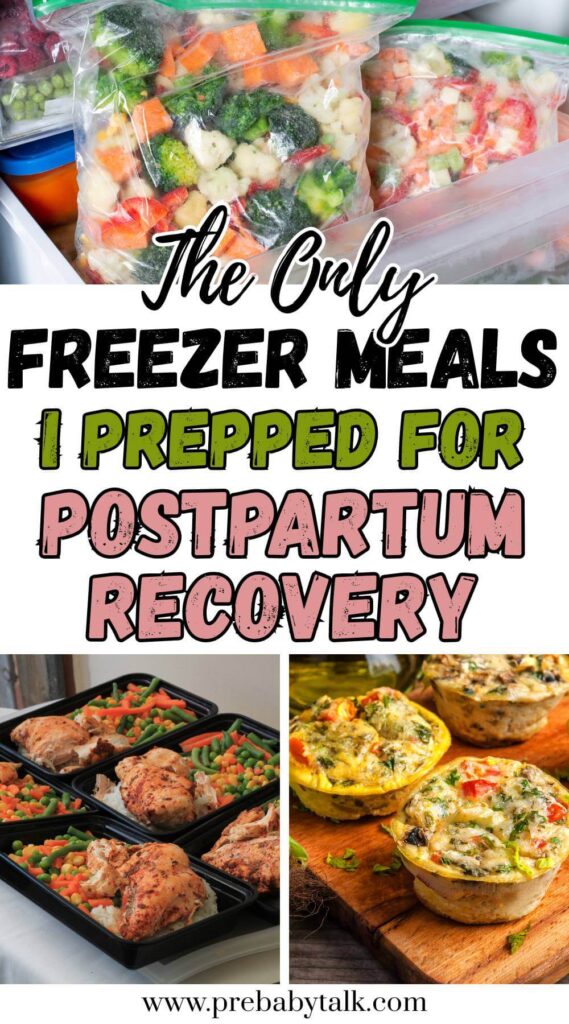
This post showed you the 9 Easy and Healthy Postpartum Freezer Meal Ideas.
You may also like:
Leave a Reply